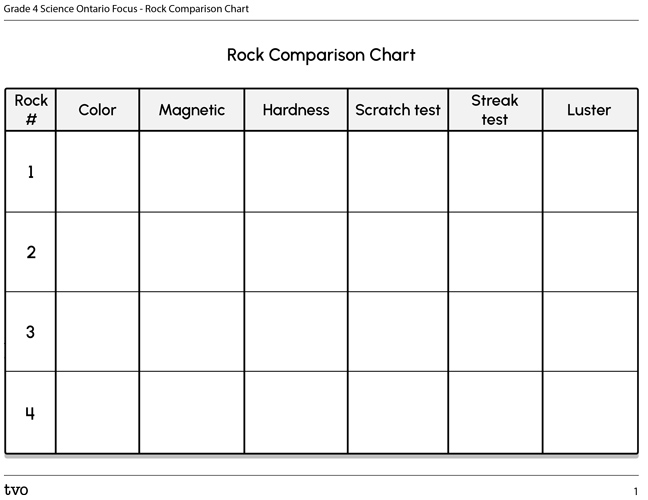Minds On
Can you tell the difference?
Find the differences between the following two images.
To complete the spot the differences puzzle you previously explored, sight was the dominant sense used. There are other senses like smell and touch that can be used when examining things like rocks and minerals.
When geologists examine rocks and minerals, they use all of their senses and more.
My pet rock
Find a rock that will easily fit in your hand. Pick one up from your local environment or playground. Get to know your rock by examining it carefully. Use all your senses except for taste. Draw a picture of your pet rock. If possible, add texture and color to your drawing.
If you cannot find a rock of your own, you can draw a pet rock, or you can imagine the following rock is your pet rock:
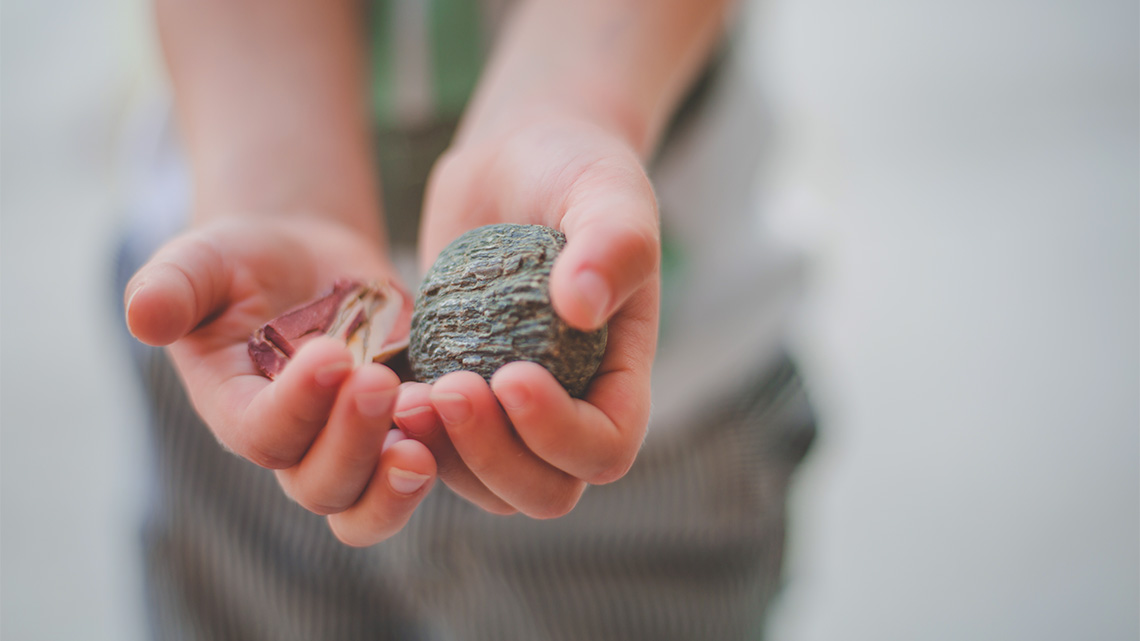
Action
Classification of rocks
This learning activity highlights people, places, or innovations that relate directly to the province of Ontario. Enjoy the exploration!

Geologists classify rocks into three groups. These groups are based on how the rock was formed in nature. The three groups are:
- sedimentary
- igneous
- metamorphic
Sedimentary rock
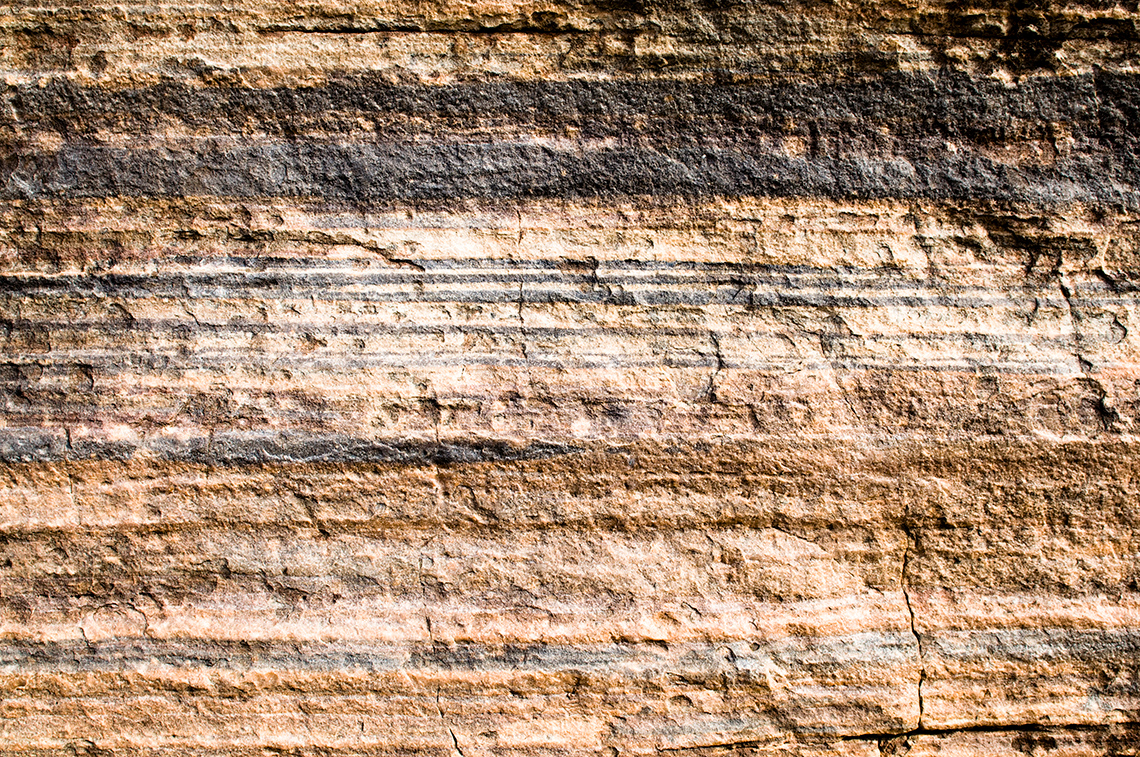
Sedimentary rock is formed at the surface of the Earth. It could be formed in water or on land. This rock is formed from eroded bits of rock, minerals, sand, and animal or plant materials that are deposited by water, wind, or ice, and then packed together in layers over a long period of time. This type of rock is fragile and can crumble and erode easily. Does your pet rock have layers?
Some examples of sedimentary rock include:
- sandstone
- shale
- siltstone
Fossils
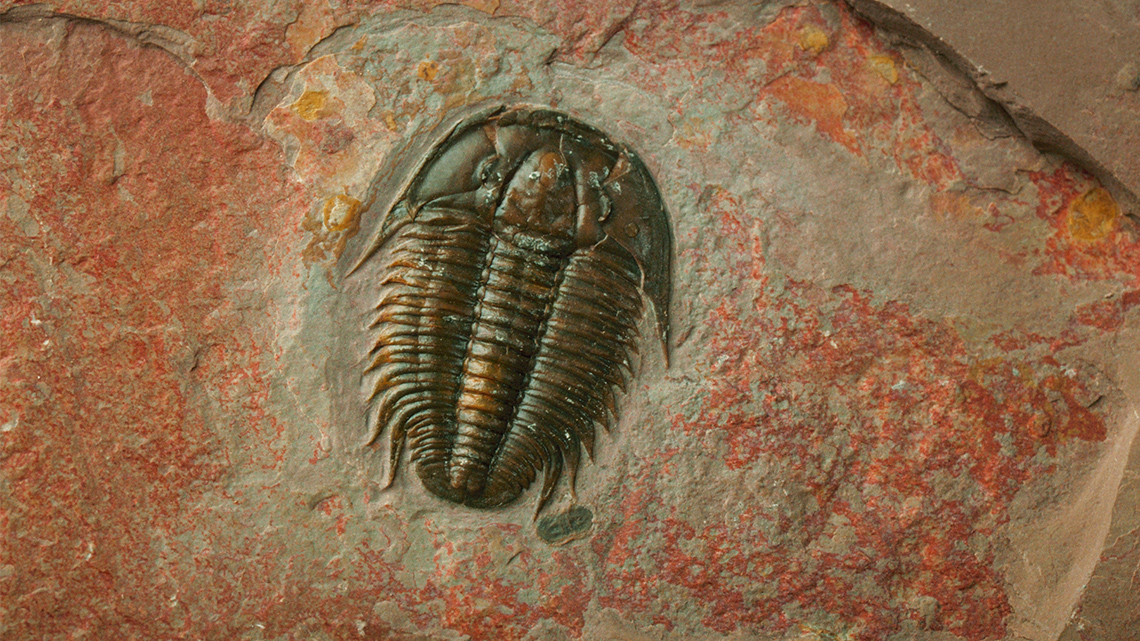
Fossils form while sedimentary rocks are formed. Layers of the silt and sediments build up on the remains or traces of plants and animals that lived long ago. Over time, the layers turn into hard rock. The fossil stays preserved in its shape by the hard rock around it. Fossils give scientists clues about the past and help them to study the plants and animals that lived long ago. For example, the fossil from the previous image is a trilobite. The trilobite lived in Ontario between 520 million years ago (mya) to 251 mya.
Are there any fossils in your pet rock?
Check out the following video about fossils and what they can tell us about the history of our world!
Pause and Reflect
The creation of fossils
How would you describe the creation of a fossil to a friend? How can fossils help us?
Igneous rock
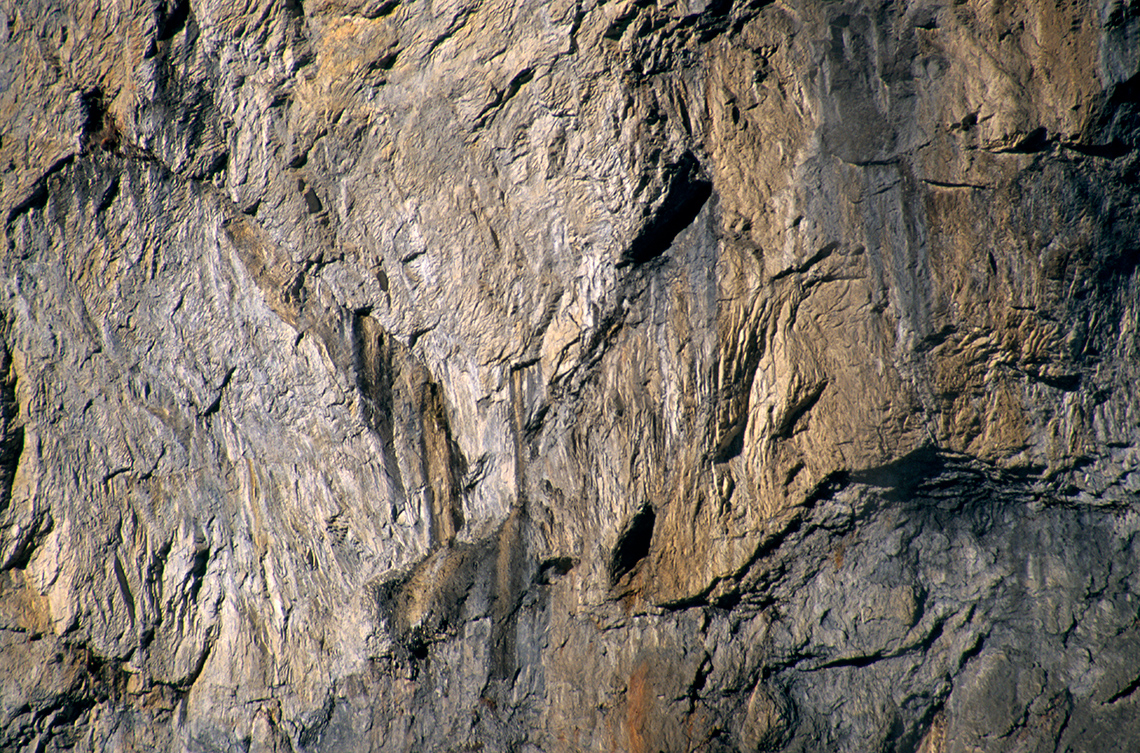
Igneous rock is formed when molten rock from below the Earth’s surface rises towards the surface, cools, and solidifies. A volcano is an example of magma coming to the surface. Crystals form on the rock as it cools. The surface of the rock and the crystals that form will be different depending on how fast the rock cooled.
Does your pet rock have shiny crystals?
Some examples of igneous rock include:
- granite
- basalt
Metamorphic rock
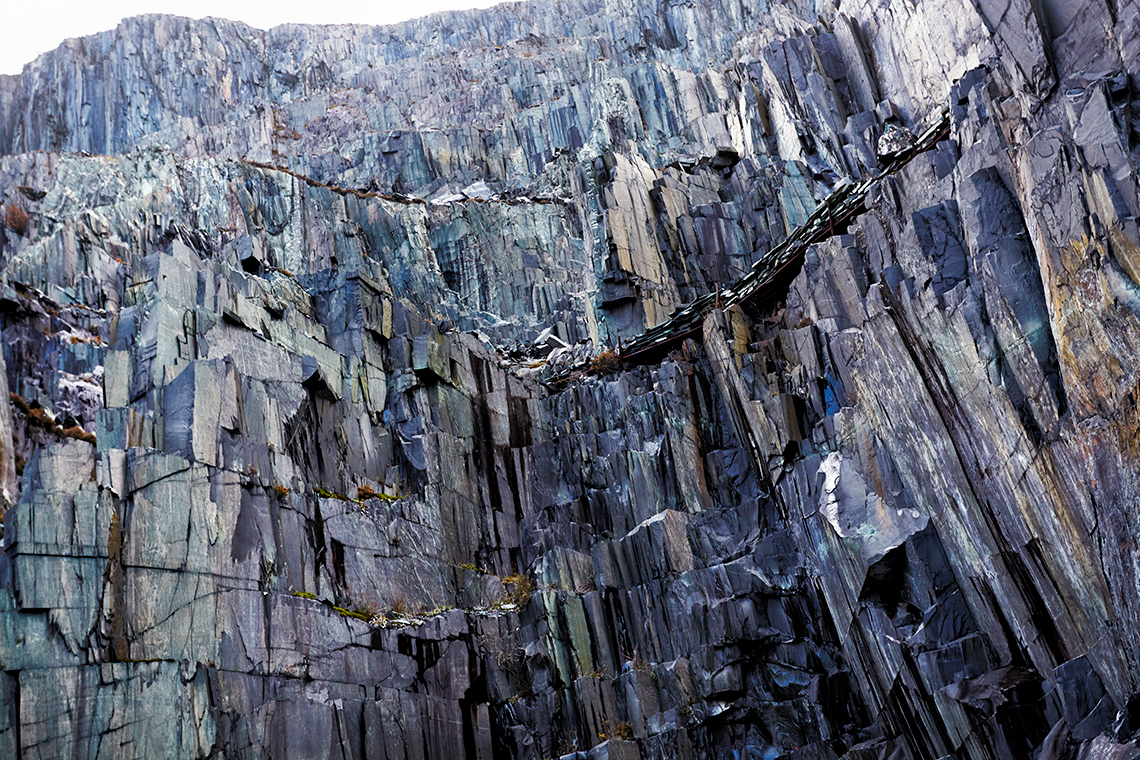
Metamorphic rock starts as sedimentary or igneous rock, and changes into metamorphic rock as a result of a large amount of heat or pressure acting on it over a long period of time.
Does your rock sound like it’s metamorphic?
Some examples of metamorphic rock include:
- marble
- slate
Check your understanding
Use your knowledge of the three classifications of rock to answer the following fill-in-the-blank questions:
For each sentence, select the missing word from the drop-down menu.
Examining a rock
Before beginning your experimentation, explore the following video that explains the scientific experimentation process. This will help guide you as you work your way through this activity.
Check out the following video to learn about the steps of the Scientific Experimentation Process.
Safety
Before you begin:
Geologists use specific tests and criteria to classify rocks.
Magnetism
Geologists have found that some rocks contain minerals that make the rock magnetic. Magnetite is a mineral commonly found in igneous rocks that makes a rock react to magnets. Not all rocks are magnetic.
If you have a rock, check it for magnetism with a magnet, if possible.

Mineral scratch test
Geologists use the mineral scratch test to determine the hardness of a rock or mineral.
If you have your own rock, try scratching your pet rock with your fingernail.
If a fingernail leaves a scratch, then this indicates a hardness of 2 or less on the Mohs Scale of hardness. The rock may contain talc, a soft mineral.
If copper can scratch the rock, this indicates a hardness of 3 or less on the Mohs Scale. The rock may contain alabaster. If you have an old penny available, try scratching the rock.
If a steel file or nail file can scratch the rock, this indicates a hardness of 7 or less. The rock could contain quartz, for example.

Mohs Scale of Hardness. One. Talc (examples: Talc, Soapstone). Two. Gypsum (examples: Alabaster, Satin Spar, Selenite). Three. Calcite. Four. Fluorite. Five. Apatite. Six. Orthoclase (examples: Adularia, Moonstone). Seven. Quartz (examples: Amethyst, Aventurine, Chalcedony). Eight. Topaz. Nine. Corundum (examples Ruby, Sapphire). Ten. Diamond
Mineral streak test
Geologists sometimes perform a mineral streak test on rocks to find out what kinds of minerals are in the rock. A mineral’s streak is the color it has when it is ground to a powder.
Streak tests are performed using porcelain plates. If one is unavailable, an old kitchen or bathroom tile, or even a sidewalk can be used.
Be sure to ask permission from an adult before performing a mineral streak test on your rock, if you have one.
Check out the following video entitled “Streak Test for Minerals” to learn more about how to perform a mineral streak test.
If possible, perform the streak test on your pet rock.
Lustre
Geologists will also examine rocks under a light. They are looking to see if the rock is shiny. This shininess is called lustre.
Using a light, examine the surface of your rock. Does the rock look dull, metallic, shiny, glassy, or oily? Rocks are a combination of minerals and other materials like sand and organic materials. Not all rocks will have lustre.
How about your pet rock? Any shiny bits?
Pause and Reflect
Rock report
Look back at the observations you made about your rock. What does your knowledge of the types of rock and the results of the tests suggest about your pet? Use your new vocabulary to write a report about your rock. Record your answers on paper, digitally, or orally. Be sure to include words that describe its classification, magnetism, hardness, streak, and lustre.
Where possible, share your observations.
So, what’s the big deal about rocks and minerals?
Now that we know a bit more about rocks and minerals, think about where you’ve seen rocks and or minerals. Try to come up with at least 5 ways. You may wish to record your answers on paper, digitally, or orally.
Did your list include:
- gravel roadways
- river or road embankments
- sitting areas at a local park or school
- part of landscaping
- maybe jewelry?
Rocks and minerals are a very important part of our daily lives. We use stone, sand, and gravel for concrete, a building material for roads, buildings, and airports. Aluminum is used for drink holders and a variety of sizes of cans, window frames, and even airplane parts. Without salt, some people would find our foods rather tasteless and, in the winter, our roadways, unsafe. Cobalt has become a very valuable and important mineral, as our cell phones, laptop computers, and tablets all use lithium-ion batteries, for which cobalt is the raw material.
Though we depend upon rocks in minerals in so many ways, there is an environmental cost. Open pit and shaft mining may pollute air and drinking water, and affect wildlife and their habitats. The road salt we use in the winter may end up in our waterways, damaging those sensitive ecosystems. Recycling may seem like the answer, but sometimes it’s expensive or really difficult to do. We need to be careful about these resources.
Consolidation
Comparing rocks (testing rocks)

Geologists perform tests on rocks to determine what type of rock it is and what minerals the rocks may contain. This is especially important when mining companies are looking for a particular mineral to mine. Ontario has some of the world’s top mines. Gold, platinum, nickel, and copper are just some of the minerals being mined today.
Geologists will perform some of the tests you have learned in the Action part of this lesson on rocks they have found to determine if they contain valuable minerals like gold or copper.
Is it a rock?
Student Success
Think!
Someone in your community has collected a small number of rocks. Examine the following image.
This image shows 9 small rocks of different size, colour and shape. They are an example of the sort of collection that someone may have. Some are smooth with rounded edges. Others are rough with sharper, more pointed edges. Some have a solid shape. Some have fragments of other colours or textures within the rock itself.
Are they rocks or minerals?
How could you help this community member find out if what they have collected are rocks, and what kind?
Can you think of 3 ways you can help them?
- Are there tests that can help them?
- Is there knowledge of types of rock that can help them?
- Are there ways that you can tell the consistency of a rock or mineral?
Record your 3 ideas to help this member determine what they have collected. If possible, share your thinking with a partner.
Note to teachers: See your teacher guide for collaboration tools, ideas and suggestions.
Reflection
As you read through these descriptions, which sentence best describes how you are feeling about your understanding of this learning activity? Press the button that is beside this sentence.
I feel…
Now, record your ideas using a voice recorder, speech-to-text, or writing tool.
Press ‘Discover More’ to extend your skills.
Discover MoreComparing rocks

Compare several rocks found in various places in your environment.
Safety reminder
Always be sure to do your safety checks before any experiment!
Compare the rocks using the testing methods you have practiced on your pet rock in the Action part of this lesson. Create a chart similar to the one below to record information so that the properties of the rocks can easily be compared.
Complete the “Rock Comparison Chart” in your notebook or using the following fillable and printable document. If you would like, you can use speech-to-text or audio recording tools to record your thoughts.
Let’s review the steps of your experiment by using the following checklist.
When conducting the experiment, did I…

Science is about reflecting and reimagining. Was your experiment successful?
Is there anything that you would change about your experiment design to improve it or the outcome?
Even if your experiment was not successful, what did you learn or confirm about the topic you were investigating?
Student Success
Think!
Did all the rocks perform the same for each test? Was the rock from the school playground different from the pet rock outside your home? If possible, share your thoughts with a partner.
Note to teachers: See your teacher guide for collaboration tools, ideas and suggestions.



